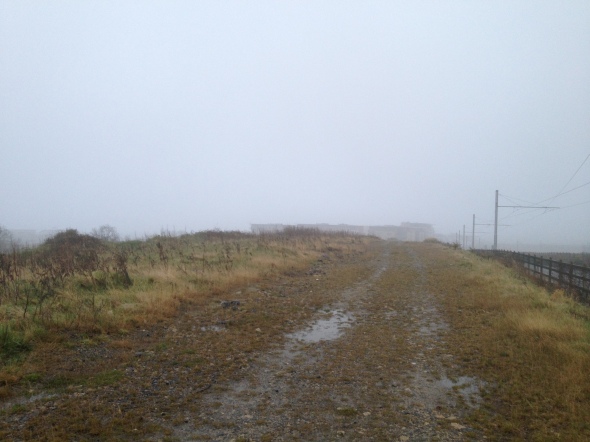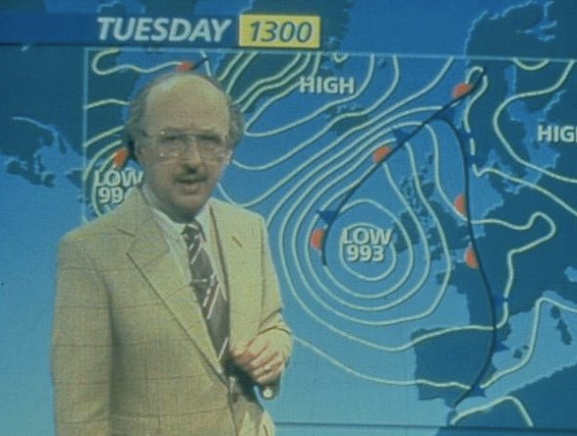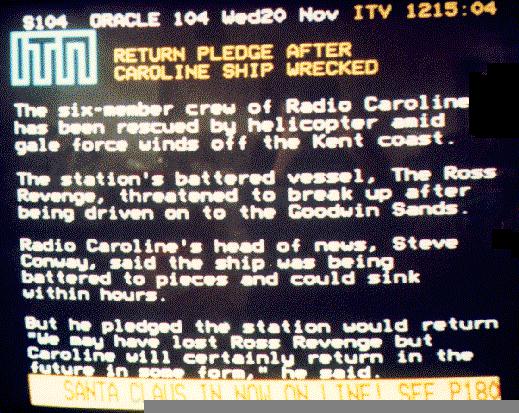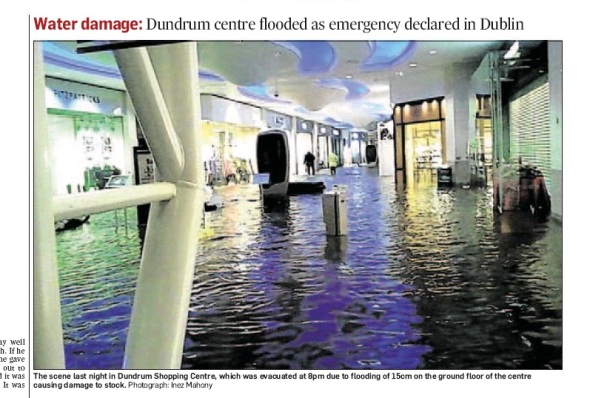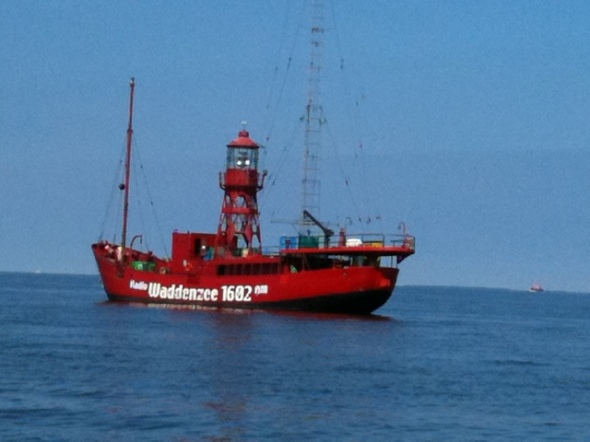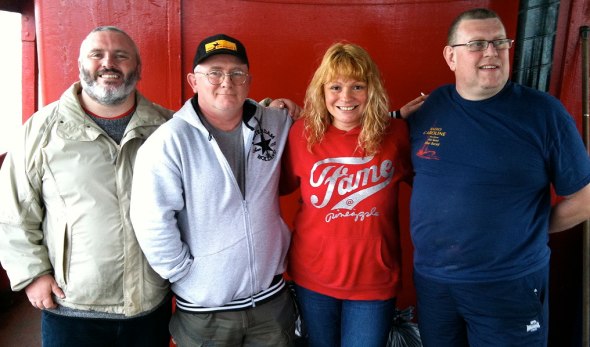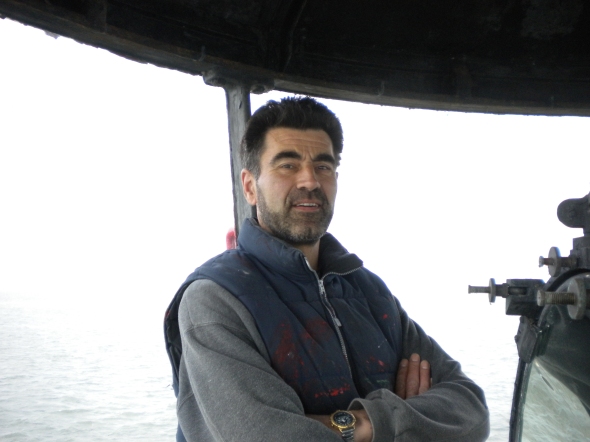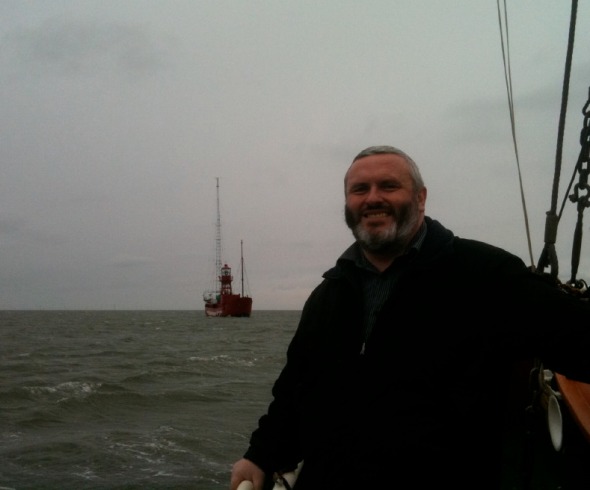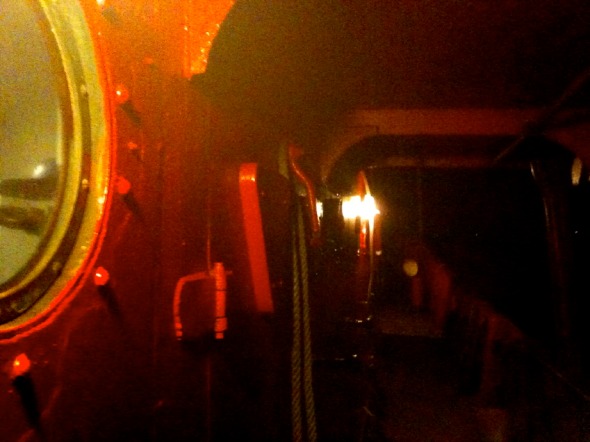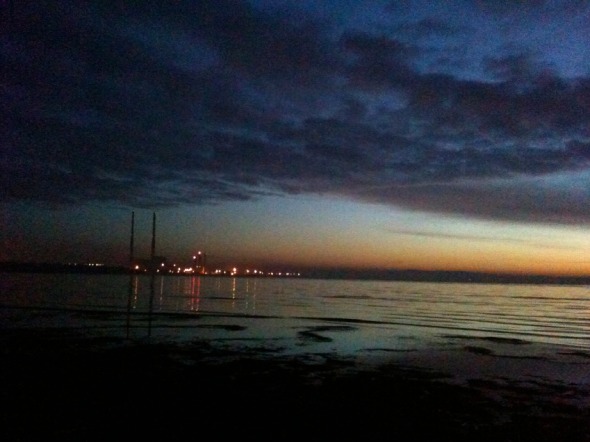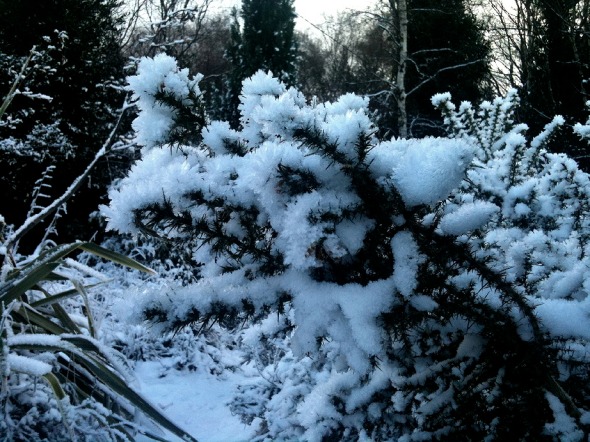Into The Crack Of Dawn [21June2013]
Posted: June 21, 2013 Filed under: Beauty, Dublin photos, Life, Odd photos, Weather | Tags: Dawn, Ireland, Lehaunstown, life, Midsummer, Photography, Seasons, South Co. Dublin, Walking Leave a commentA series of photos showing the progress of dawn, not over one day, but at the same time each day from winter to midsummer, as I walk through the fields to work
In the summer of 2012, I found a long deserted pathway through the fields at Laughanstown in south county Dublin, near to a place where I was working at the time. My discovery and first lunchtime amble along the pathway is illustrated in my short story The Melting.
The pathway runs through open fields alongside the LUAS tram line, and I soon got into the habit of taking a daily walk along the pathway, getting off the tram a couple of stops before walk, and happily walking in solitude through fields alive with fresh morning air, only the occasional whirr of a passing tram to disturb the birdsong. A lovely way to start the day, drifting happily in thought and body. Were I a lamb, you might even say that gambolled happily across the meadow each morn.
When winter came, I was loath to give up this pleasure, even when darkness made it more difficult, and started bringing a torch so I could pick my way along the path towards the lights of civilisation – and work – in the far distance. It was cold, dark, and sometimes hard going, but the sense of solitude and the fresh air more than made up for it.
Far from any houses, the blackness was absolute, and one morning (Jan 2nd this year) at 0724 I took a photo to illustrate the darkness of the walk, zooming in on the lights of Tullyvale and Cherrywood in the distance.
The next morning, the blackness was not quite complete – a tiniest sliver of a crack of dawn was visible over distant mountains, and I took another photo to show the difference a day (and two minutes later) had made.
This gave me an idea. As I walked the route at least three days a week, always at the same time (taking the same outbound tram departure) why not take a series of pictures, to catalog how the dark of winter slowly gave way to the dawn of spring, and the daylight of summer as I took my morning walks.
Those first two pictures were taken randomly, and not at exactly the same point, and possibly not covering exactly the same span, but for this project I would need some way of locking my physical location, so that the field of view would be as close as possible to exactly the same in each picture.
So I used a line of electricity pylons to determine the photograph point – they would not be in shot themselves, but when I reached a point on the path where the crosstree of one pylon aligned exactly with the southern edge of another, I would stand in the righthand rut of the track, thus controlling my physical location. I would then line up the second closest overhead wire carrier on the tramway to the rifghthand edge of the photo, and this would ensure I was covering the same area in each shot. Only the vertical plane had no real means of control.
And so, here are some of the results, as we journey from winter to spring, at the same time each morning, give or take a couple of minutes.
A week after my first photos, the 11th of January 2013 at 0724. The difference in the amount of dawn is quite visible, it is still pre-dawn lightening of the sky, but the clear day makes it much more visible. The field and pathway are still in absolute blackness at this time.
January 15th at 0724, another clear morning, apart from a low lying bank of cloud over the distant hills.
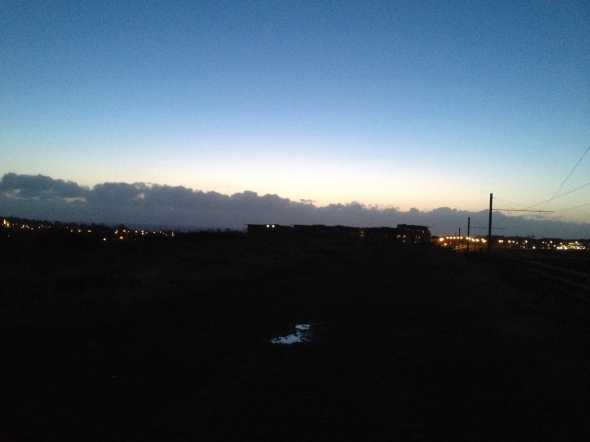 Just a couple of week later, the 6th of February, at 0722. Quite a difference in two weeks – another clear day, but this time the sky is blue, the shapes of things are more visible, and I can see the puddle ahead of me.
Just a couple of week later, the 6th of February, at 0722. Quite a difference in two weeks – another clear day, but this time the sky is blue, the shapes of things are more visible, and I can see the puddle ahead of me.
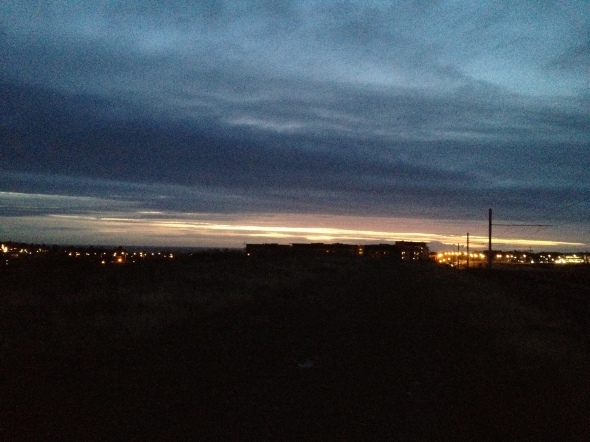 The next day, February 7th at 0724, shows the difference the cloud makes – dawn is at the same point, but no chance of seeing anything on the ground.
The next day, February 7th at 0724, shows the difference the cloud makes – dawn is at the same point, but no chance of seeing anything on the ground.
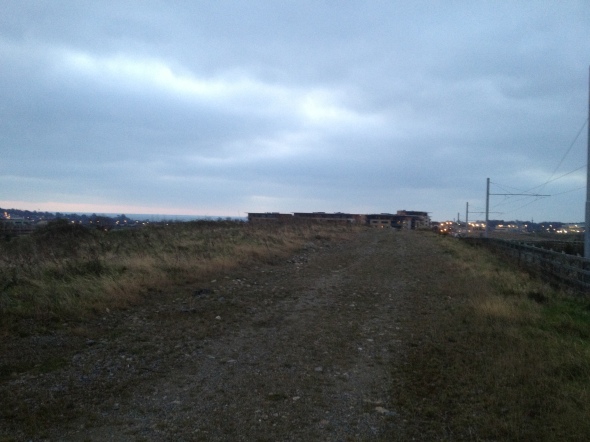 Now this is amazing – it is only two week later, the 21st of February, at 0723, and yet the difference in light, even with a totally overcast day, is amazing. Now everything is visible. To the right is the tram line, heading towards Cherrywood in the far distance. The buildings in the centre of the picture are the apartments of Tullyvale. To the left of them a sliver of the Irish Sea is visible, and then Killiney Hill rises on the left edge of the photo.
Now this is amazing – it is only two week later, the 21st of February, at 0723, and yet the difference in light, even with a totally overcast day, is amazing. Now everything is visible. To the right is the tram line, heading towards Cherrywood in the far distance. The buildings in the centre of the picture are the apartments of Tullyvale. To the left of them a sliver of the Irish Sea is visible, and then Killiney Hill rises on the left edge of the photo.
 Four days later, the 25th of February, again at 0723, and a different type of cloud cover darkens the scene, but leaves room for a lovely yellow and pink line above lower lying clouds concealing the rising sun.
Four days later, the 25th of February, again at 0723, and a different type of cloud cover darkens the scene, but leaves room for a lovely yellow and pink line above lower lying clouds concealing the rising sun.
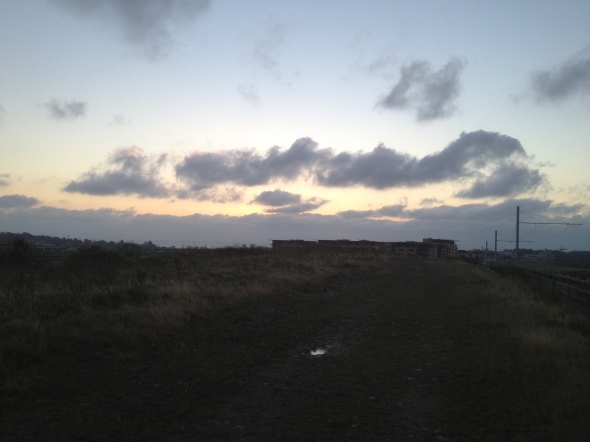 The following day, Feb 26th, at 0723, the clouds are different again.
The following day, Feb 26th, at 0723, the clouds are different again.
A couple of weeks later again, 7th March at 0723, and it is now pretty much daylight. It’s been raining for days, and the distant hills are lost in soft Irish mist.
The 29th of March at 0728, the sun is fully risen, and hidden behind the clouds, sending lovely shafts of light down onto the sea. The foreground looks darker to the camera due to shooting into the sun, but was bright enough to the human eye.
April 17th at 0724 – no fear of sunlight affecting the camera here, as the weather has turned “Irish” again!
 May 1st at 0725, the dun is shining brightly now.
May 1st at 0725, the dun is shining brightly now.
 The following day, May 2nd at 0725, shows a more dreamy, cloudy skyscape.
The following day, May 2nd at 0725, shows a more dreamy, cloudy skyscape.
And then . .
And then I moved away from that location
but . . .I knew I must come back for midsummer photos.
 The day before mid summer – June 20th at 0722
The day before mid summer – June 20th at 0722
and finally
Midsummers day itself, though hot and sunny later, was wet and misty early on – June 21st 2013 at 0726.
And now I’m working on the other side of the city, and I don’t get to walk through the fields each morning any more. But thanks to a whim and a sudden inspiration back in the dark days of winter, I have a whole selection of photos of my beloved few moments of morning commune with nature, to go with a whole set of cherished memories.
I hope you’ve enjoyed the trip as much as I have!
Steve
Memories From A Damp Past: The Housewives Of South Dublin [16June2013]
Posted: June 16, 2013 Filed under: 1980s, Life, Publishing, Weather, Women | Tags: Dublin 1980s, Jobs, life, Memory, Prayer, Sales 4 Comments
“Oh your poor thing” the woman who answered the door said to me “come inside and let me look after you”. I was about to find out if all those stories about bored housewives and door to door salesmen were true . . .
What stirs memory can be very subtle – sometimes a combination of atmospheric condition is needed along with place to really stir the dead leaves of the past.
I had totally forgotten about my wildly unsuccessful three-day career as a door-to-door salesman, fresh out of school, more than 30 years ago.
Until I drove through Ballybrack in the rain a couple of days ago. I have driven along Churchview Road a fair few times in recent years, with barely a flicker of memory, but this particular morning the sky was grey and heavy, a soft rain was drizzling down, the trees were dripping . . . and instantly I was transported back 30 years, to the day I trudged this road with a sack of books, and knocked on every door of every road leading off it . .
Even at the time, the smart part of my brain knew that any job that I could just walk straight into without experience and with barely a five minute interview, was probably not worth having. But I was determined to stand on my own feet and be independent, and I resolved to give it my all.
The publishing company was based in Parnell Square, in the heart of Dublin city centre, and the product was children’s books, and – yes, you guessed it – encyclopedias.
I was to be that living cliche, the door to door encyclopedia seller!
Judging by the number of people (15) that went through the three-day (unpaid) training course with me, the operation had a huge turnover of sales staff. We trained Monday to Wednesday, and then, on Thursday, were were unleashed on the public for the first time. The whole group of us were taken by bus to Sallynoggin in southeast Dublin, and there met by a supervisor in a van who gave us our stock, and split us up among the myriad of new and old housing estates over the surrounding few square miles.
It was a typically wet Dublin day – not a downpour, not blustery, just a steady seeping, weeping soft wetness from a heavy grey sky.
I was given Ballybrack – the vast complex of then fairly new housing along all the roads that lead off Churchview Road – Watson Drive, Watson Avenue, Watson Park, Blackenbush, Pinewood, and what felt like a million other places. I started with zest, and swear I must have have knocked on 500 doors that day . .
Disheartening of course, both for me, and the poor people whose day I disturbed. Perhaps one sale in every 100 houses. But I was glad to have a job and to be (perhaps) earning money, and I kept at it. I would, of course, be paid commission only, so what I earned would depend wholly on my success rate.
As a well brought up (and well read) boy, my sales spiel, if not successful, was at least polite. I was smiling, courteous, and no matter how brusque my dismissal at the door was, I always thanked the householder for listening to me, and apologised for taking up their time uninvited. That last touch actually netted me one of my very few sales – a doctor, who had initially sent me away, called me back as I was walking down the driveway and bought an encyclopedia, explaining that he had never encountered a salesman so well mannered before!
That was one of only two sales the first day, and the next day I was back in the same location, to knock on the doors of a further 400 or so houses.
Late in the morning, I hit the jackpot. Knocking on yet another door, which was opened by a rather harassed looking young woman, I listened in disbelief as she told me that herself and a friend, to whom she quickly introduced me, were in the process of setting up a creche, and had just been discussing the fact that they needed childrens books! I can’t remember how much I sold them, but it probably accounted for more than half of all my sales for the whole week. When I say “creche” this was of course, the pre-modern-regulation early 80s version – i.e. 7 or 8 toddlers being looked after by the pair in a normal 3-bedroom terraced house, hence their rather fatigued demenour.
Later in the afternoon, footsore and weary, and still with far too many unsold books in my heavy bag, I knocked on yet another door, and encountered that fable of lurid fiction, the housewife who didn’t want to buy anything, but who liked the look of me, and invited me in.
Luckily for me, as I was far too innocent in those days to know how to handle such a situation, this was Ireland in the 1980s, and not America or (as I would discover a few years later) the much more liberated England. The Irish Mammy who said I was a lovely looking young thing and invited me into her house did so in order that . . she could give me a cup of tea, and suggest that we say a few prayers together to the Virgin Mary that I might get a better and more rewarding job !
And even if I was disappointed that nothing else was on offer (like the purchase of a book – what else would I be thinking?) the tea was very welcome, and I was touched by her concern for my welfare, and her determination to offer up prayers for my future.
The following day, although a Saturday, was to be a work day, as the publishing house insisted on a sic day week. This time I was taken to Finglas, for an utterly soul destroying day in which I knocked on seemingly a million doors, was chased away from many of them, and did not sell a single book in 9 hours of pounding the streets. Somehow, my southside accent and polite sales spiel did not seem to be quite so appreciated here.
At the end of the week, I had managed to earn myself the princley sum of £13, but out of this I had paid for my bus fares and meals, which reduced my earnings to around £5, or, I calculated, around 3p for each door I knocked on. I knew then that it was not for me, but was pleased with myself that I had lasted longer than most of the class – of the 15 trainees, only 12 had gone out selling on the first day, only 5 remained on day 2, and there were just 2 of us to cover Finglas on the Saturday. And, presumably, a new class of 15 fresh-faced school-leavers to start training on the Monday morning . .
Now, many decades later, and with a solid career in IT management over the years, not to mention a quarter century of radio work, and an emotionally rewarding writing sideline, that first week of commerce after leaving school is long forgotten in my past. But memory is a funny thing, and the weeping sky and rain sodden trees along Churchview Road brought it back to me, clear as a bell, as I happened to drive through the area last Thursday morning.
So long ago that it seems to me it might have happened to another person. Many of the people whose doors I knocked on will be gone now. I wonder how the two ladies setting up the creche fared – was their career as short-lived as mine, or do they now run one of those big modern purpose built childcare centres around the city?
And I have to smile when I think of the woman who gave me tea and prayed for me to have a better career. So nice of her to care for a stranger.
Somehow, I’d love her to know that her prayers were answered.
Steve
LW 252 Tower (Ireland) – Pics
Posted: March 17, 2013 Filed under: broadcast engineering, radio, Signs, Technology, Uncategorized, Weather | Tags: AM Broadcast, Anorak, Atlantic 252, Ireland, Longwave, Meath, radio, RTE, transmission towers, Warning Signs 4 CommentsSome shots of the 252Khz Longwave transmission tower in Co. Meath, Republic of Ireland, currently broadcasting RTE but originally erected for Atlantic 252. Pictures taken Sunday 17th March 2013.
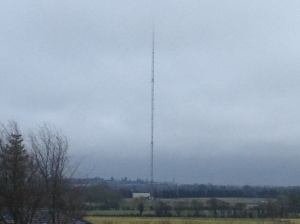
You can click on any picture for the high-res version. This is the tower as seen in the landscape of Co. Meath. It is actually a better shot than the close-up ones, as there are so many obstructions of the view from the roadway closest to the site.
I don’t normally go out of my way to photograph broadcast sites – I usually prefer to think and talk about the content rather than the technology – but a friend in the UK asked me for some pictures, and as I was walking in a forest only about 20km away today I thought “why not?”.

The base of the tower. This was taken through a wire mesh fence, and a small gap in the trees, so only possible to get one part of the tower at a time in shot.
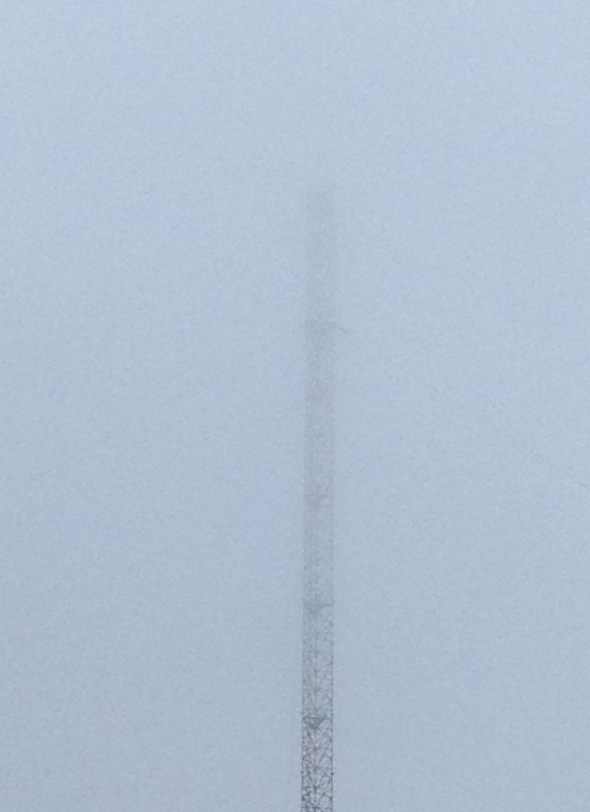
The upper sections vanishing into the mist. It is planned to paint the top 84m of this tower red and white, and to replace the current warning lights with ones of lower intensity.

Planning application notice on site for retention of modifications, also revised colour scheme and lighting.

When I last passed here about 15 years ago, it was very easy to see into the site, but the boundary trees planted around the tower have all grown up now.
So there you have it, 252 site on a typically misty St. Patricks Day.
Steve
The Tower, One St George Wharf (photo)
Posted: January 16, 2013 Filed under: Beauty, London, Technology, Weather | Tags: Helicopter, life, London, News, River Thames, Space Leave a commentLooming into the mist above the River Thames, this massive tower and crane captured my interest on a recent walk, but would later be the scene of a tragic helicopter accident.

The Tower, One St George Wharf seen from Westminster, with the tip of the crane shrouded in low cloud
Walking along the Thames Path from Westminster one cold and misty day in October 2012, I couldn’t help but be drawn to the sight of the massive tower under construction on the south bank of the river. Standing far taller than the surrounding skyline, the crane alongside and tethered to it served to make it look somewhat like a rocket on the launchpad, waiting to blast off with spacebound cargo, the image all the more appropriate given it’s location just streets away from the London HQ of the British Interplanetary Society.
I was compelled to photograph it, and it made a great landmark on my walk as I came towards and finally past it.
How sad today to see it at the centre of a very tragic accident involving a diverted helicopter which crashed having clipped the crane in cloudy conditions.
However much we reach skywards, however proudly our buildings and our machines rise upwards in defiance of the laws of gravity, it takes so very little in the way or circumstance, or weather, to bring us crashing down again.
But we will keep building high, keep flying, keep reaching for the stars. It’s what we do.
Steve
Hissing In The Wind (or: They Will Never Listen)
Posted: October 15, 2012 Filed under: 1987, Radio Caroline, Ross Revenge, Shiprocked!, Ships, storms at sea, Weather | Tags: 1987 Hurricane, BBC, Great Storm Of 1987, Kent, Michael Fish, Pirate Radio, Popular Myths, Shiprocked!, Ships, UK, UK Met Office, Weather 1 CommentThe above photo needs no introduction.
You know the spiel by now.
25 years ago today/tomorrow, the night of the 15th/16th October 1987 saw The Great Storm, or The 1987 Hurricane, or whatever you would like to call it. Millions of trees uprooted, millions in property damage, 18 people killed, road, rail and power disrupted, and none of it forseen or foretold by the met office.
Amid great sniggering, the clip of Michael Fish reading the weather forecast on BBC TV at lunchtime on the 15th will be played, with him saying there is no hurricane coming, and the talk will be of how utterly the Met Office failed to prepare the Great British Public for the terrible storm.
That’s the collective memory, and everyone knows it is true.
Except . . it isn’t.
I was there, and I was right in the teeth of the storm in all it’s fury, and I had been watching that lunchtime weather forecast, and I had heard Michael follow his comment about there not being a hurricane (technically true) by telling everyone that there was going to be some very stormy weather overnight. Ah, but they never play that bit of the clip do they?
But more than that, I was expecting him to say this, and I knew several days earlier that the morning of the 16th would see a great and violent storm coming in from the southwest . . because the Met Office had told me, and other BBC viewers. Far from being unprepared, we were well prepared for a storm, and although, yes, it was much more severe than we expected, it is wholly unfair to say that the nation was not warned.
The nation was, you see, mostly indifferent to the weather warnings over the preceeding days, and much more concerned with waiting for Neighbours to come on after the news bulletin. But the warning was there, as far back as the previous Sunday.
I should clarify here that myself and my colleagues on board Radio Caroline were always very attentive to the weather, and always watchful and mindful of what it was going to do, as in our exposed anchorage 18 miles off the Kent coast the weather had a profound impact on our day to day life – on our level of comfort, on the ease of our doing our jobs, on our prospects of being resupplied at any given time, and on the quality of our sleep. So we were very attentive and invested in the weather forecasts.
You might expect me to tell you of the amazing struggles to stay on the air during the great storm, and the frightening moments and waves as tall as buildings that we encountered that day, but that is not the purpose of this article. I’ve written about it in my book Shiprocked – Life On The Waves With Radio Caroline, and there is another account of it written by myself, which you can read for free online at Soundscapes (EDIT: for some reason the article cannot be directly linked from here, but if you google “soundscapes conway hurricane” you will find it)..
No, this piece is my attempt to shout my truth unheeded into the wind yet one more time, and try to tell you that the story of Michael Fish and the sleeping Met Office is . . just a story, a popular narrative.
Unfortunately, it has over time become THE Story, the only one that is told.
So, did the Met Office warn about the storm, and how far in advance did we know?
We knew as far back as Sunday 11th October, four or five days earlier, that we were in for an almighty storm in the early hours of Friday 16th.
Needing to be conscious of the weather, and as Caroline’s Head of News, one of the things I never missed was the Farming Programme on Sundays on BBC1 (not sure if it was called Countryfile back then, but it was essentially a more down to earth and less jazzy version of the programme that still runs to this day). The programme always featured a long-range weather forecast for the next 7 days, and this was highly useful to us on Caroline for assessing if we were going to have some bumpy days, and when there might be a weather window for supply boats to reach us.
I was particularly conscious of the forecast on that particular Sunday, as we were short staffed (two presenters down), running short on certain supplies, and crucially had not received new records for a number of weeks (pretty essential for a contemporary music station). The large supply ship that came out from France that weekend did not have these people or items, but brought a message with it that there would be a small boat coming from the UK on Friday with fresh staff, supplies, and music.
Looking at the long-range weather forecast on the farming programme, we knew that this was just a pipe dream, and that there would be no new supplies on Friday – the weather would be far too rough for even the much bigger French tender to come to us, never mind a small fishing boat.
So although the ferocity of those mountainous seas at daybreak on Friday, 25 years ago, did astonish us, we could not, truly, say we were not warned.
Next time you see the clip of Michael Fish, and you hear the story about how forecasters did not predict a storm, don’t believe it.
I’d like to believe that my personal truth would counter the popular myth, but i know that, like on that morning a quarter of a century ago, my words will be lost in the howling wind.
Steve
Facing Death At Dawn . . And Life Afterwards
Posted: November 20, 2011 Filed under: 10 Things, broadcast engineering, Early Phantom, non-Fiction, offshore, Phantom 105.2, radio, Radio Caroline, Ross Revenge, Shiprocked!, Ships, storms at sea, Technology, Weather | Tags: Change, Goodwin Sands, International Waters, life, Life Changing Experiences, Pirate Radio, radio, Radio Caroline, Rescue, Storms, Survivor, UK, Weather 3 Comments
The past is indeed another country, but the future is a map that we can draw for ourselves if we dare.
It was 20 years ago this morning, (20th November 1991) that I came to the end of the roughest night I had ever known in all my years at sea with Radio Caroline, and faced what I came to believe would be my last ever dawn.
Aground on the infamous Goodwin Sands, which have claimed hundreds of ships and thousands of lives, we were gradually rolling over, each wave pushing us a little closer to the tipping point where the ship would capsize. Ironically, although there was not enough water to float her, there was more than enough to flood into her and fill her up if we went sideways . . more than enough to drown in.
The waves were towering in the North Easterly Force 11 winds, the seas icy – we wouldn’t have lasted more than a few minutes if we went over.
The brave men of Ramsgate Lifeboat had already tried to rescue us and failed, running aground themselves, losing a man overboard in the process (happily quickly recovered by safety line). Now we were waiting for the helicopter, but it seemed we would be in the water before it arrived . .
Certain that we would be drowning in minutes, the floor beneath us already at a 45 degree angle, we hugged each other, shook hands, and said goodbye. We knew we were going to our doom . .
The story of that morning, and our eventual rescue by the RAF helicopter R166 is described in detail in my book Shiprocked – Life On The Waves With Radio Caroline, but even the printed word cannot do justice to the memories which are still vividly seared onto my brain, even all these years later.
I absolutely believed that I was about to die, and that morning, and in particular that moment, has changed my life since then.
The 20 years I have lived since that morning on the Goodwins is a bonus, and the older I have got, the more I have appreciated this, and the more I have lived my life with zeast and purpose. The sudden seeming end of Caroline in 1991 (though not the final end, as it has bounced back and is adpating to a new age) instilled in me a knowledge of the impermanance of states of being, and ensured that when I got involved with Phantom FM in later years I treasured each moment, and drove myself to both give and take the maximum from every day that I worked there.
In life too, I reach out with lust for living to take the most from each day, and push myself to do and experience more and newer things.
Life is a bonus, and I am determined to spend that bonus to the full.
Many people around me comment on my seemingly unflappable calm when faced with difficult situations. This too comes from that morning on the Goodwins, for as I see it, I have been minutes from an icy drowning death, so why should anything that happens in a more normal work or life based situation cause me to panic?
Time has been kind to Radio Caroline too, and that morning, seemingly a point of closure for the station was to be in fact the first step in forcing it to adapt to a new path, which though seemingly bleak for much of the 1990s, has blossomed in latter years into an unprecedented period of stable broadcasts, with new technology enabling the station to be heard in undreamed of quality in previously unreachable countries.
20 years on I have spent the night of the 19th/20th November sipping wine with close friends, and thanking my lucky stars for all the richness of life and the benefits of new technology that both I and Radio Caroline have enjoyed in the last 20 years.
It’s right to raise a glass and look back, but the biggest gift of all is to be able to raise my gaze and look forwards.
Steve
What Lies Beneath – Why Dundrum Town Centre Flooded
Posted: October 25, 2011 Filed under: Dublin photos, Uncategorized, Weather | Tags: Building, Civil Engineering, Dublin, Dublin Floods, Dundrum Town Centre, Geography, Landscape, Rain, Shopping Malls, South Co. Dublin, Water 4 Comments
Steve digs out his photos of the construction of South Dublin’s fashionable (and flooded) mall, and remembers what it was they built on top of . .
- From the front page of Irish Times 25th October 2011 – © Irish Times
The dramatic scenes of water bursting into the upmarket Dundrum Town Centre mall were some of the defining images of the Dublin floods of October 2011, and the front page picture from todays Irish Times shows how badly the centre has been affected. Since its opening six years ago it has been my favourite of the Dublin suburban shopping centres, but its devastation by floods does not surprise me as a local with intimate knowledge of the grography that it replaced.
It could be, in fact, a perfect example of of the boom years building frenzy taken to its logical consequences, as the building of hundreds of apartments close by in the following years helped seal its fate.
The village of Dundrum has always perched on a slope at the bottom end of a narrow valley, with a good-sized stream (or small river) running through it. Various complexes lined the high ground on one side of the valley – the old PYE Television factory, later industrial estate, the 1970s original Dundrum Shopping Centre, and the old H Williams store at the southern end (which became Super Crazy Prices, and then Tesco). But the bottom of the valley and the river was always left pretty much wild, and I used to roam along its length in my childhood years, fancying myself as a fearless explorer as I waded upstream and forced my way through undergrowth.
In more recent years, as I made my way to work on a sluggish 48A in 2000 and 2001, the glimpse of the stream surrounded by green land as we crossed over the valley on the Ballinteer Road bridge just before the crossroads always gave a little glimpse of forgotten rural idyll. Until the day the bulldozers moved in, and they started building.
Here is a shot I took sometime during 2001 or 2002 which shows both Dundrum Town Centre and the Dundrum Bypass under construction. The picture is taken from a temporary pedestrian bridge over the valley errected during the period when Ballinteer Road was closed to traffic as a new, wider road bridge was built complete with car-park ramp downwards into the centre.
On the left is where Dundrum Town Centre now stands, and you can see the spot where the underground car-parks and delivery section join the bypass.
The valley floor has been leveled, and the stream boxed in, ready to be buried underneath the new development in a culvert.
When this photo was taken, it had been dry for a good period, and the stream was low, however it often ran much higher in wet periods. Nevertheless, the culvert once roofed would seem more than proof against even a four or fivefold increase in flow during very rainy periods.
However, in the years following the completion of the centre, hundreds if not thousands of apartments in dozens of new developments were built upstream, with much of the run-off from all these acres of new concrete flowing into the stream or the local drainage system. The huge flow of water from the Ticknock Hill development alone can be seen during wet periods cascading down a series of steps beside the M50 junction, and into the watercourse of this stream. Plus, all of the green land that lay undisturbed in this little valley is now built over, no longer able to absorb rainfall and run-off.
In the exceptional rainfall of the last 24 hours, when a months rain fell in a day, once the culvert was at full capacity, where else could the water go?
I’m not saying the planners failed here, this is an exceptional event, but perhaps, when we have building booms in future, we should be looking at things like runoff in the context of what else will be built in the area later, and planning for “once in 80 year” events.
Yes it will cost. But as much as the damage that now needs to be made good?
Steve
So Who Are Radio Seagull?
Posted: October 24, 2011 Filed under: broadcast engineering, Classic Rock, Music, New Music, offshore, Radio presenting, Radio Seagull, Ships, storms at sea, Weather | Tags: Music Radio, Offshore Radio, radio, Radio Seagull, Ships, The Netherlands, Transmitters, Waddenzee 1 CommentThe recent test-transmissions on 1395Khz by Radio Seagull have driven quite a few Google search requests to this blog, so I’ve decided to give a quick run-down on the station for any new visitors, as well as for those who follow me for my other content and might be curious.
Please note my disclaimer: I am a Radio Seagull presenter myself (Saturdays 7-9am and pm CET, 6-8am and pm UK/Irish time) so you are reading an insider rather than an outsiders point of view. Having said that, I also have to point out that all views are my own, and not neccessarily endorsed by the station.
So, what is Radio Seagull?
Radio Seagull is a full-time, permanent, licenced terrestrial, English-language radio station based in The Netherlands, specifically the town of Harlingen, in the northern coastal area. As well as AM coverage emenating from Harlingen, the station can be heard worldwide via its online stream, accessible from the station website – www.radioseagull.com
How can I hear Radio Seagull?
In The Netherlands the station shares its AM frequency (1602Khz) with Radio Waddenzee, a regional station servicing the north of The Netherlands in the Dutch language. Waddenzee is heard from 7am-7pm and Seagull from 7pm to 7am on mediumwave, however Seagull is available 24 hours a day online.
(Radio Waddenzee takes its name from The Wadden Zee, a large area of sea on the fringe of the North Sea, but partly protected by a chain of islands 20km or so from the coast.)
As well as terrestrial and online outlets, Radio Seagull is sometimes carried as a sustaining service on other stations around the world. Currently the station is being relayed as the content of a series of test transmissions on 1395Khz on AM, which are being made from the Radio Seagull ship, the Jenni Baynton. These are scheduled to continue until mid-November (but Seagull will continue to be available on its permanent frequency of 1602Khz, at all times).
What type of programmes does Radio Seagull have?
Radio Seagull features both modern alternative and classic rock, as well as a wide variety of specialist music shows. Some presenters specialise in new and alternative music, others present more general shows. Details can be found at the website www.radioseagull.com.
In order to cater for international listeners in different time-zones, the schedule is organised into groups of programmes in 12-hour blocks, repeated once the same day – so that, for example, a show aired at 3-5pm will also be aired at 3-5am, giving people in different parts of the world the chance to hear each show in their “daytime”.
How is Radio Seagull different from other stations I can hear on the internet, or local stations on FM?
Radio Seagull’s programming philosophy is to gather together experienced and professional presenters from around the world, people who are passionate about the music they play, or very knowledgeable in their specialist area, and to give them complete creative freedom to produce the best shows that they can. Unlike larger commercial radio stations, there is no restriction on playlist size, and as a result the music you hear on air is incredibly diverse and wide-ranging.
Presenters come from all across Europe and further afield to work on Seagull, and many are people who have been involved in radio for a long time.
So what’s all this about a ship?
Radio Seagull (and its sister station Radio Waddenzee) are housed on board a former British Lightship (LV8), the Jenni Baynton, which is normally berthed in the harbour at Harlingen. The ship itself is an attraction, bursting full of history, and much restored since its acquisition by Seagull in the early 2000s, and it makes a wonderful base for the radio station – lots of room for studios, engineering facilities, radio mast, and cabins where crew and visiting DJs can be accomodated during special offshore broadcasts. The station also has landbased transmission facilities.
But the ship is more than just a static base.
Once a year, for the last several years, the station has put to sea for periods of about a month each summer, with crew and DJs living on board, a great opportunity for friendships to be rekindled and knowledge to be swapped, as well as recreating some of the excitement of the old offshore radio days (a number of the Seagull presenters, myself included, are veterans of the former offshore pirate stations such as Radio Caroline).
Who is behind Radio Seagull?
Seagull is the brainchild of Sietse Brouwer, a Dutch businessman and radio presenter who also spent some time working with Radio Caroline in the 1990s. Sietse has a passion for good radio, and a great love of ships, and putting the two together in his home town of Harlingen has occupied a great part of his time for the last 10 years.
Where can I get more info / how can I listen?
The best place to start for both is the website – www.radioseagull.com
You can also see more of my pictures from Radio Seagull’s offshore adventures at the following pages:
https://steveconway.wordpress.com/seagull/the-jenni-baynton-at-sea/
https://steveconway.wordpress.com/seagull/inside-the-jenni-baynton/
https://steveconway.wordpress.com/seagull/jenni-baynton-crew/
https://steveconway.wordpress.com/2011/06/07/dreamy-seagull-pics/
If you are a new visitor, I hope this has answered your questions, and made you curious enough to listen.
I can be heard every Saturday 7-9am and pm CET, (6-8am and pm UK/Irish time).
But don’t just listen to me – the rest of the presenters are superb!
Steve
A September Moment
Posted: September 5, 2011 Filed under: Dublin photos, Poetry, Weather | Tags: Dublin, Ireland, life, Poetry, Robert Frost Leave a commentI had an hour to spare on Saturday, unexpectedly, and I used it to wander out the North Bull Wall past Dollymount Strand and into the bay. The view from there is urban, across the port to the longer South Wall, and then beyond it to the south city and the Dublin Mountains, but it’s lovely all the same. I’ve biked and walked and climbed over every inch of that city and those hills in my childhood, and they are as much a part of me as my DNA.
It was a typical “Dublin Day” on Saturday – overcast but not wet, a fresh breeze from the southwest scudding the multitude of low-hanging clouds across the landscape, just scraping the hilltops. It was cool without being cold, and the day held enough promise of rain to deter the noisy crowds who normally throng the beach without actually releasing any rain.
The sea, that sky, those hills . . I can remember a thousand Dublin days just like it while growing up.
I found a little rock to sit on and just drank all this in for a long time, relishing a moment of passive enjoyment of place which I indulge in far to rarely these days. It was good for recharging the soul.
I drive myself too fast to do too many things these days, and forget sometimes to stop and enjoy the smell or the roses, the kiss of the rain on my cheek. A fulltime and senior job in the IT world with much pressure, a book to be written, another half done, short stories and poems bubbling up as well, two radio shows to be planned and recorded each week, and several other projects on the boil. I’m never bored, and I love it, but all the same . . I musn’t forget to feed my soul as well as my career(s).
All those years ago, as a schoolboy, I remember enjoying the poetry of Robert Frost. Two poems in particular stuck in my mind through adulthood.
“The Road Not Taken” was my favourite, and was both a guide to my choices and a description of my life for many years, and I hope, still now.
“But I, I took the road less travelled by
And that has made all the difference”
But it is another poem of Frosts that comes into my mind much more frequently these days: “Stopping By Woods On A Snowy Evening“
As a boy I loved it for its description of dark snowy woods, ripe for exploration, and wondered why the adult, who so obviously found them allureing, yet chose not to tarry.
But now, in a busy life, I find myself thinking of that last verse much more often, in the full understanding of the adult’s responsibilities that force him to cut short his simple pleasure and drive on.
As I sit there looking across the bay at those could-capped hills and the domains of my childhood, I resolve to try to take more “time out” for myself and try to make just a bit of space in a busy world for watching snowy woods.
But not now. There is a man I have to meet at 1pm in East Wall, and then its off to Loughlinstown where I have several hours work awaiting me.
I get up to walk back to the car, happy that I have just gifted myself a lovely September moment of pleasure.
I’d like to stay longer, but I have promises to keep.
And miles to go before I sleep
And miles to go before I sleep.
Steve
In 2010, I Lived.
Posted: December 31, 2010 Filed under: 10 Things, 1980s, Dublin photos, Fiction, Irish writing, Love, Music, New Music, New writing, non-Fiction, Odd photos, offshore, Phantom 105.2, Prose, radio, Radio Caroline, Radio presenting, Radio Seagull, Ross Revenge, Sex, Shiprocked!, Ships, storms at sea, Weather | Tags: 2010, Bristol, Dublin Airport, emotion, Growth, Hot Air Balloon, Music, Offshore Radio, Opera, Radio Caroline, Radio Seagull, review, RNLI, Sunrise, Sunset 2 Comments
- Looking back . . the sun and all that is Dublin can be seen from the very tip of the Great South Wall in the centre of Dublin Bay
Looking back, I can’t recall another year in my life when I have lived as vividly as I did in 2010.
Despite 2010 being bleak economically and politically both home in Ireland and pretty much everywhere else in the west, despite long hours and stress in various workplaces, despite some non-threatening but quite inconveniencing medical blips, despite my car heater dying just in time for the coldest December since records began . . 2010 was a year in which I really lived, in which old emotions were reawakened, and new ones discovered, and my store of life experience grew more than it has done in a long time.
I had set myself a challenge at the end of 2009 to start doing things I had never done before, to open myself to new experiences beyond my comfort zone. And while I didn’t get to the arbitrary goal of “10 things” during the year, I reached 5, two of which were experiences that profoundly moved or enriched me, and a third which brought back childhood memories entwined in a futuristic setting.
Not all of the great things that happened to me during the year were as a result of this self-challenge, but perhaps the attitude it engendered in me of being more open filtered through to other things too.
So what made my year?
Well, some unique experiences came about as i sought to push myself into new things.
Taking part in the Bristol Balloon Fiesta was certainly a “high” point of the year, and my first ever hot-air balloon flight, as part of a mass ascent of more than 80 balloons within an hour at dawn, was a unique and moving experience, so much so that I felt to write about it in purely descriptive journalistic terms would be . . to miss some indefinable element of the experience.
Twisting it in my mind, it instead inspired me to write a short story “A Bristol Awakening” that is neither fact nor fiction, but also both. A very intimate story, it has been received well at a number of public readings, especially by women, and I am hoping to see it published in 2011.

Launching from a Bristol hillside at dwan, with ballons of every shape and size coming before and after us

Drifting lazily and silently through the sky over Bristol, with the Avon Gorge, the Bristol Channel and Wales visible in the distance
Slightly more down to earth, though involving a different sort of (non) flying, as one of my challenges I put myself forward to the Dublin Airport Authority to be one of the special testers of the new Terminal 2 before it opened. Apart from fulfilling my curiosity about the new building, and allowing me a sneak peek at new transport infrastructure, which I’ve always been interested in, the experience reminded me of aspects of my past that I had long forgotten, and also gave me a chance to get my own back on customs, just for once. You can read the details in my post Mr. Beagle Goes To London (Not).
Something I have never wanted to do, and felt I would always avoid, enriched my life and gave me a wonderful experience when i tried it as part of the “going outside my comfort zone” element of my 10-things challenge. A visit to the Royal Opera House in Covent Garden, accompanied by a an impossibly glamourous companion, opened a whole new world of experience, sight, sound, and stimulation to me. I enjoyed it more than I could possibly have imagined, and do intend to write up the experience here at a later date.
Pushing myself outside my comfort zone, doing what I would not normally consider doing was one of the elements i wanted to achieve in drawing up my list of 10 things, and I am so very glad I did this.
As the year comes to an end, I’ve so far ticked off 5 things, and have more still in planning, with some space left on the list for spontenaity.
So 2011 should continue in similar vein, and to be honest, when I reach 10, why stop there?
Of course, there were other things which made 2010 an exceptional year for me, some planned, others unexpected.
A couple of things that really moved me were radio related, and did not come about as a result of my challenge list.
Going in March to Ramsgate to do a reading from Shiprocked for the benefit of the RNLI, brought me face to face with the men who came to my rescue on one of the darkest days of my life, 19 years earlier.
Meeting the crew of the lifeboat who battled through a Force 10 NE to come to our aid when the Caroline ship was aground on the Goodwin Sands was a profoundly humbling experience, all the more so because of the warmth of the welcome I received, and the support they showed for Caroline despite having been put through hell that morning and nearly losing their own lives on account of our stubborn decision to stay on board the apparently doomed vessel.
I won’t forget the men of the Ramsgate Lifeboat, and will be making another fundraising trip to see them in November 2011, on the 20th anniversary of the grounding.
The same weekend I revisited the Ross Revenge for the first time in many years, and was invited to join the current-day lineup of Caroline on satellite, which, despite the many years of my absence, felt like a real homecoming.
(I can be heard on Caroline every Monday 2-4pm, Sky Digital Ch.0199 and via RadioCaroline.co.uk )
Another emotional moment came about in May, after I had been invited to join the crew of the Dutch station Radio Seagull, which was celebrating a month long offshore broadcast, 8 miles of the coast of Friesland.
There were many memories stirred by being offshore for the first time since 1991, though the most intense of these was to come on me unexpectedly.
The week I spent at sea with Radio Seagull was bliss, with old memories awoken, and new friends and new memories made at every moment of each day. (See the posts OFFSHORE AGAIN and Seagull Day 1 and More Seagull Pictures and Clear White Light and A Ferry Large Tender as well as Seagull Offshore – The Pictures for the week as I blogged it at the time)
But the most vivid experience of that week came for me, unexpectedly, in the middle of the night and alone, and had nothing to do with the radio side of the visit. Being given the job of staying up on watch overnight for one of the nights, while usually regarded a something of a chore, for me brought both fear and redemption, as I was finally able to lay to rest the ghosts of what had happened on the Caroline ship, many years earlier, when we drifted, unheeding, onto the deadly Goodwin Sands.
For all that the storm in 1991 had been so fierce, and our ship so run down and unable to navigate that we could not have resisted being swept onto the Goodwin Sands even if we had realised earlier that our anchor chain had broken, I had carried with me these many years a nagging sliver guilt that I should have known, should have been more alert, should have done better.
Now, here I was again, and for the first time since that fateful night, entrusted to watch over a ship at anchor at sea, and in the grips of bad weather too. I was both siezed with fear that it would all go terribly wrong on my watch, and grateful for the chance to prove myself dilligent and keep the most careful of watches. I checked our position regularly, I did a full round of the ship and checked the anchoring cables every hour, I saw us safely through to dawn, and I slayed a dragon that had slumbered in a corner of my mind for many years.
The week was over too soon, but I was delighted to be asked to join the staff of Radio Seagull and to contribute a weekly show from my own studio in Dublin, with my own choice of music – a mix of new and alternative music as well as classic rock, with a bit of blues and soul mixed in. Presenting these shows on Seagull have been an immensely satisfying experience for me.
(I can be heard 7-9 am and pm each Saturday, on 1602Khz MW in The Netherlands, and worldwide at RadioSeagull.com )
Phantom 105.2 in Dublin also continued to be a source of great enjoyment for me, and though I had to move away from regular weekend shows towards the end of the year due to domestic commitments, the station and its staff still feels like an extended family for me, and keeps me informed on new music trends.
There were lots of mini high points in 2010 – from an unexpectedly beautiful sunrise encountered one morning on my way to work, to, finally after all my years on this earth, a proper White Christmas.
There was also another experience, quite unexpected, which made me feel like a teenager again, one unremarkable Saturday afternoon at a railway station in an unremarkable British city . . but I won’t go into that one here!
Suffice to say that, for me at least, 2010 has been a year in which i started living and growing anew, despite being at an age where comfort and stagnation would be more usual.
May 2011 have more of the same . . and new . . for me . . and you.
Happy New Year
Steve Conway
Ferries In The Mist
Posted: May 23, 2010 Filed under: Dublin photos, Ships, Weather | Tags: Docklands, Dogs, Dublin, Ferry Travel, Ireland, Mist, Photography, sea, Ships, Weather Leave a commentI was down at my favorite location in Dublin docklands, the Great South Wall, walking my friends Oran and Sarah and their three dogs on Friday evening.
It had been an exceptionally sunny day, and within seconds of our arrival a wall of sea mist came rolling in towards us, blanketing the bottom of the Pigeon House towers, blotting our view of the bay, and muffling and distorting the sounds of nearby shipping.
We watched the Irish Ferries Ulysses creep out of the port at quarter speed, a grey mass almost impossible to perceive against a swirling grey background, sounding its foghorn every minute as it shared the narrow channel with a cargo ferry creeping in the other direction.
A new twist on one of my most loved places.
Steve






